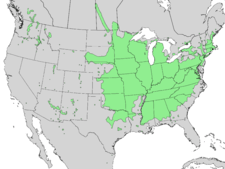Rhus glabra
| smooth sumac | |
|---|---|
 | |
| Rhus glabra fruit | |
| Scientific classification | |
| Kingdom: | Plantae |
| (unranked): | Angiosperms |
| (unranked): | Eudicots |
| (unranked): | Rosids |
| Order: | Sapindales |
| Family: | Anacardiaceae |
| Genus: | Rhus |
| Species: | R. glabra |
| Binomial name | |
| Rhus glabra L. | |
 | |
| Natural range of Rhus glabra | |
Rhus glabra (smooth sumac) is a species of sumac in the family Anacardiaceae, native to North America, from southern Quebec west to southern British Columbia in Canada, and south to northern Florida and Arizona in the United States and Tamaulipas in northeastern Mexico.
One of the easiest shrubs to identify throughout the year (unless mistaken for Rhus vernix, poison sumac, in the absence of mature fruit) smooth sumac has a spreading, open-growing shrub growing up to 3 metres (9.8 ft) tall, rarely to 5 metres (16 ft). The leaves are alternate, 30–50 cm long, compound with 11-31 leaflets, each leaflet 5–11 cm long, with a serrated margin. The leaves turn scarlet in the fall. The flowers are tiny, green, produced in dense erect panicles 10–25 centimetres (3.9–9.8 in) tall, in the spring, later followed by large panicles of edible crimson berries that remain throughout the winter. The buds are small, covered with brown hair and borne on fat, hairless twigs. The bark on older wood is smooth and grey to brown.
In late summer it sometimes forms galls on the underside of leaves, caused by the parasitic sumac leaf gall aphid, Melaphis rhois. The galls are not harmful to the tree.
External links
- Bioimages: Rhus glabra
- Smooth Sumac on eNature
- Germplasm Resources Information Network: Rhus glabra
- Smooth Sumac of Kansas
- Identifying Invasive Plants Detailed photos to distinguish Smooth Sumac from similar plants
- Vegetation Management Guideline Control Recommendations
-

Rhus glabra below North Fork Mountain, West Virginia, USA.
| Wikimedia Commons has media related to Rhus glabra. |